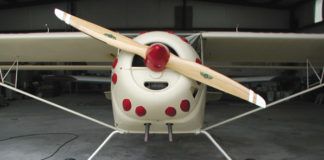Dan Parker will be a familiar name to those of you who recall a piece from the January 2008 issue of KITPLANES. Hes a man of no small ambition, who aims to fly to a new world record altitude of 31,051 feet in an aircraft he designed and built, weighing less than 200 kilograms. I checked in to see how things were coming along.
The finished airplane is planned to weigh 415 pounds empty, with a 46-foot wingspan, a length of 17.5 feet, and a Rotax 503 powering it to a Vne of 80 mph. Parker likes to compare it to an F-15. Its got the same wingspan at 1.5% the weight, he says.
The roll-up-door industrial space that is both his home and shop still hums to the sound of the bandsaw, and it shows. The last piece of the structure, the boom, is just being closed. It is 20 feet of carbon fiber that has the same cross section as the mainspar-no coincidence. Both parts are made using the 20-foot aluminum channel that was close to Parkers theoretical ideal shape.
The boom is mostly plies of carbon fiber at +/-45 orientation for twisting strength, with lengthwise sticks of Graphlite unidirectional graphite in the corners, which gives the tube its bending strength, Parker says. For all that length, the naked boom half weighed 9.2 pounds before adding foam bulkheads and splice plates to join the two halves into one. He calls it his subsonic boom. This is the last piece of structure, he said, so then its down to completing the subsystems and finishing.
Not all is roses. The rudder pedals are a good example of the dictum that the weight of the rejected ideas must exceed the weight of the finished airplane or you missed something. Parker says the pedals are an example of why things take so *&#$ long on the plane.
Although Parkers not a large guy, he needs custom rudder pedals. The footwell is a little pinched, so I needed narrower pedals with a narrower base that would let me scoot everything forward, he says. Each generation is about two-thirds the weight of the one that came before. First was machined aluminum, second was flat foam-core carbon fiber, and final is a built-up carbon monocoque [no core].
Last January I submitted that the price would be as low as the weight given Parkers clever approach to building: no lathe, mill or sheet-metal tools. Anything that needs machining goes from a CAD layout to a shop, where one-offs are knocked off cheaply. Molds are made from existing materials.
Turns out I was right. Parker figures he has $15,000 in parts in the airplane, plus a couple thousand hours of labor, three Dremels, 20 pairs of scissors and a few hundred Band-Aids. Then there’s the cost of an aeronautical engineering degree from Stanford, where he teaches classes on working with composites. In that, hes far ahead of Orville and Wilbur. By the way, not adjusted for inflation, $15,000 is about what the Wright brothers spent on their first airplane.
Ingenuity at Work
Parker has designed the plane with the gas tank directly over his head. Thats not unusual, but he hasnt used the typical fuel gauge made of transparent fuel line. Not wanting any fuel lines in the cockpit, he built his gas tank of carbon fiber for low weight, and then added a translucent fiberglass window on the roof to let sunshine in, with a similar window in the back face. Light in the tank makes seeing the fuel easier than trying to spot the top of a clear liquid in a dark tank. He also added another fiberglass window just above his head. Now he has a line of sight to the fuel, no fuel passing through the cockpit and two fewer tank penetrations.
An especially nice safety touch is the method for removing the door. Most emergency-release mechanisms rely on removing the hinge pin. Parkers system removes one half of the hinge from the door. Surprisingly, the door doesn’t just fall off, it explodes away from the fuselage. The door half of the hinge is held in place not with screws, but with spring-loaded pins, which pass from the outside, through the hinge and through the door. Two piano-wire-type pull cables are inserted through the ends of the spring pins, arming the door so that when the cables-which terminate in a single knob-are pulled, the spring pins are ejected from the hinge. The spring-load on the door latch is then free to shove the door forward into the airstream. I guess if I have to pull this while in flight, I wont even see it go. Itll just disappear in less than one second, he said.
Parkers primary lesson to date is that if he were to start over, the plane would look completely different, rely more on existing technology and be done in half the time. Previous airplanes Ive built were a kit where I assembled someone elses work, he said. This time I have to design it, build the kit and then assemble the parts. That takes a lot longer.
Launch date is not decided, but by the time you read this, Parker will have made some test flights, as full assembly is taking place as this is written.
For more information on the project, visit www.parkerprojects.com/altitude.htm.




